Animal Behavior Midterm 1
1/49
There's no tags or description
Looks like no tags are added yet.
Name | Mastery | Learn | Test | Matching | Spaced |
|---|
No study sessions yet.
50 Terms
territory
smaller, actively defended from conspecific intruders, contains a key resource
Home range
larger, undefended area used by individual can overlap with other individuals
Spatial extent at individual level is made up of the territory and home range
Leaving range for long period is migration
Species range
full extent of species geographic distribution
What is migration and why does it evolve
ersistent, undistracted locomotion
Not wishy-washy
Relocation on a greater scale and duration than daily movements
Relocation between regions with alternating favorable and unfavourable conditions
Migration is an adaptation that increases fitness
About 20% of bird species are migratory
Some cases can cause birds to change from being migratory to being non migratory
Cuckoo bird lays their eggs in the nest of another bird and the mother bird over extends herself to feed the bird
Cuckoo bird follows its own species migration pattern and migrates to the same location as its parents
Three major drivers of migration
Unpredictable changes (weather, food resources, predators, shelter)
Competition for resources among conspecifics ( food, breeding sites)
All species cannot have the same pattern because then there is too much competition for resources
Predictably unfavorable environmental conditions (annual cycles)
Normal migration
all individuals or populations of a species move between ecological zones
partial migration
some individuals or populations migrate while others remain resident
Internal Circannual Rhythm
Controls annual life cycle
Hormonal change → restlessness (zugunruhe)
Physiological changes prepare for migration
Increase caloric intake and body fat
Fat is much lighter than muscle
Increase gut size, flight and cardiac muscle hypertrophy
Feathers molt
Grow specialized feathers for long distance flight
Physiological changes (migration)
Go from hyperphagia to hypophagia
Regression of gut, gizzard liver (reduce weight)
Because they are not eating while flying
Once they land, they cannot eat because their gut is still too small to digest food
Example in Munich of the change in bird migratory patterns due to urbanization
Males and females in the forest both migrate to Egypt
In cities, males became sedentary
Outside of breeding season, males and females do not interact
Males are larger and may be able to survive winter better
May rely on human food
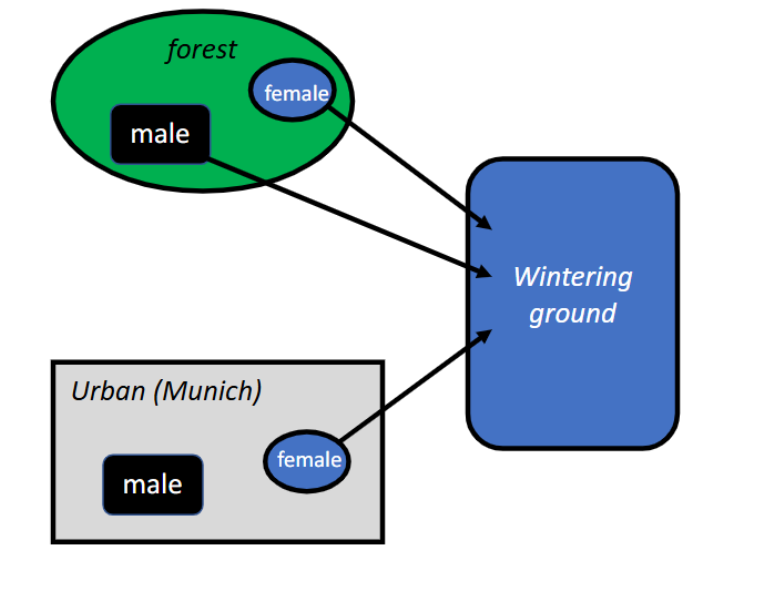
most important cues for far range migration
Map step
Know the bearing and the distance of the migration goal
Maps are learned, innate or both
Maps are often multimodal (olfaction, magnetic field, landmarks etc)
Compass step
You know where North is and therefore all other directions
Use poles
Use celestial maps of stars or the sun
most important cues for near range migration
Most important cues
Using local landmarks
Near range →Example of Gannets
They don’t leave their local area unless they have to
They have to meander in a random pattern until they start to recognize their local landmarks
Some birds never encounter their familiar landmarks and never go home
map vs compass
A map is a representation of physical space that allows you to determine where you are here you want to go, and how to get there.
compass allows you to orient the map to the physical directions of the world
Beehive Experiment with von Frisk
Training with sunlight exposure for bees
Place food source in a specific location
Once they find the food they go and come back
Testing whether they use odor sensing to see the location
Food vs observer
Change the odor of both
Change orientation of hive, hive is moved to a new area
Takes place at all times of day
They always go where the food source used to be
Food aligned with sun position
Can use sun as compass because it has fixed movement
Must account for its movement relative to fixed features of the Earth surface
At a later time, would they follow sun or food
Straight to food
Homing Pigeon example
Release in Maine area =
They will return back to their original
At 9pm
Train bees at 9 pm and 9 am separately
Train them to do different at 9 amd 9pm
how do bees know how far to go
Honey bee waggle dance to communicate food sources
What to do when its too bright outside
Compound eyes allow to translate rays of light into a polarized version → humans can learn but we are not good
Will see polarized light in different orientations
ALlows to create a very precise compass
Desert ants (ft, in paper)
Sun can be used even in a very cloudy day
Our eyes cannot see polarized light
Magnetic Fields and navigation in pigeons
Pigeons always made a b line back to their loft
On cloudy days they had a much harder time.
When new technician Dwayne did the experiment, the birds could not return to Ithaca
Turns out the one difference is that Dwayne drove a European car, and the birds were in the backseat
Engine is in the back of the car, disorients the birds
The magnetic coils in the engine have a very high magnetic field
Messes up the birds ability to sense the Earth’s magnetic field
Another lab continued these experiments
Put magnets on the head of the birds and change the magnet polarity
Do the experiment in sunny and cloudy environments
When sun compass is available they ignore the magnetic information
When sun compass is not available, they use the magnetic compass
When magnet is reversed on a cloudy day, they fly in the opposite direction of where they should
Makes it disadvantageous to only follow the magnetic compass of the poles as a species
closer you get to the poles, the more vertical it gets
At the equator, the magnetic field is parallel
It is these lines that are followed by the birds
There are anomalies in the magnetic field lines around the Earth, particularly in the South of the world
Can also indicate that you are in that position
Birds are sensitive to the inclination angle and the strength of the field
Compass can act as a map
Birds can actually see magnetic fields as color
Blue/green light → no disorientation
Red/yellow light (something not typically seen at dusk) → the birds get messed up.
Are magnetic fields only processed in the eyes?
Probably not
Iron-mineral based hypothesis
Movement of iron minerals in the trigeminal nerves could be reacting to magnetic fields
Light-dependent hypothesis
Photoreceptors
Songbirds that are very good at migration have cytochromes in their eye cells
Dark spot in the birds vision indicates direction of gravitational field, and will get darker when it is at a higher incline of the field lines, the spot will darken
Logger Head Turtle Example
Endangered species
At night, little turtles hatch and immediately go towards water
Cues they use
Follow moonlight towards the water.
However, with humans and beach front homes, the light pollution confuses the turtles and they would go to condos
Also because turtles would go to a specific light frequency that was being used in the condo lights → change light frequency
Goal is for turtles to swim perpendicular to waves and want to hit the water stream in the ocean
Difficulty near North Atlantic current because that would take them to an area that is too cold
At this point, the turtles should exhibit a change in behavior and swim downwards in another direction
At this point, the cue they are looking for is using Earth’s magnetic field
Study by putting little turtles in tanks where they artificially change the Earth’s magnetic field
When presented with the corresponding inclination angle, they all swim southwards
Navigation Cues Summary
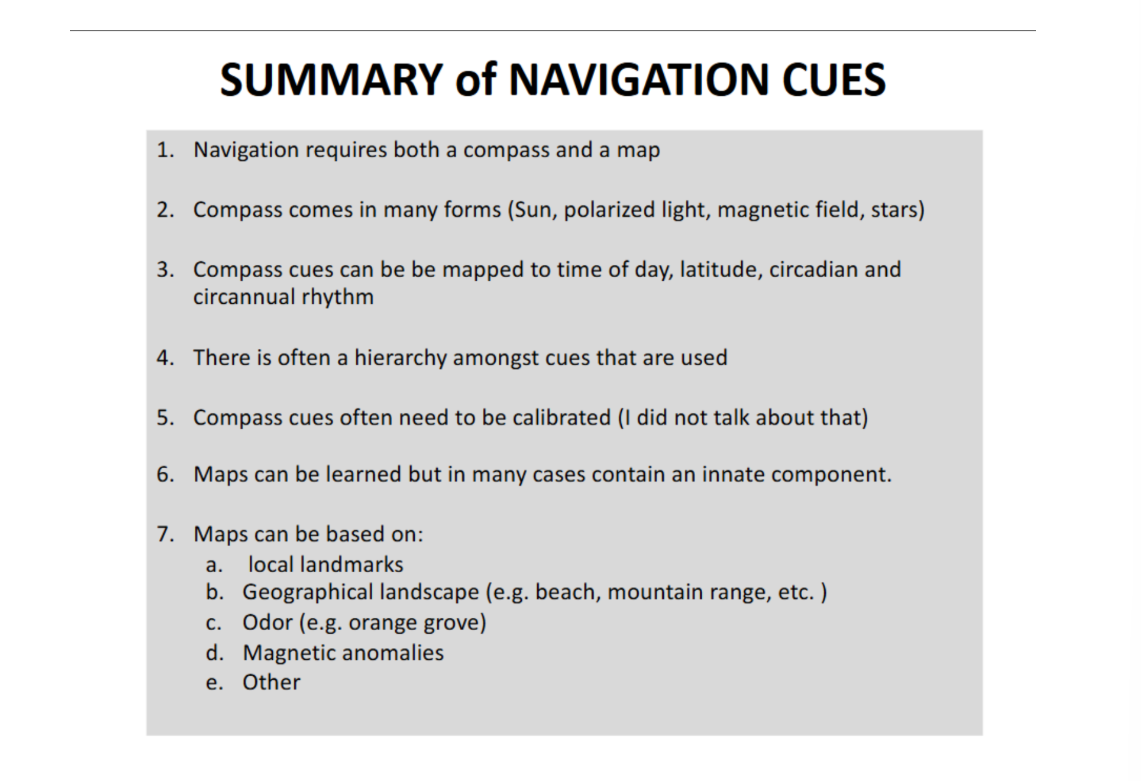
Ideal Free Distribution
Dung Beetle example
Individuals move freely across habitats to forage
Individuals are distributed according to the resource abundance
Fitness benefits are equal among individuals
Put more food on one side, always ends up with 2 fish/4 fish
Example of grocery lines
Numbers are fluid/ strategy is fluid
Example of phenotypic plasticity (change behavior due to resources in the environment)
Dung beetle males compete for females
Gets less fertile → less females present
Some males are still present on poor dung patches
Some wait until the end
Dung dries up over time to it gets less ideal to pay eggs on
No inherent competition → doesn’t really happen IRL
Everyone is spaced out evenly so that they can optimize getting everyone’s needs met
Too many individuals on rich habitat → might be beneficial to move to the lower resource patch instead
Ideal Free Distribution
Individual choose best habitat available to them
Habitats should be filled so that the profitability for an individual is the same in each one
Decisions about where to settle depends upon what others in population are doing
Example of phenotypic plasticity
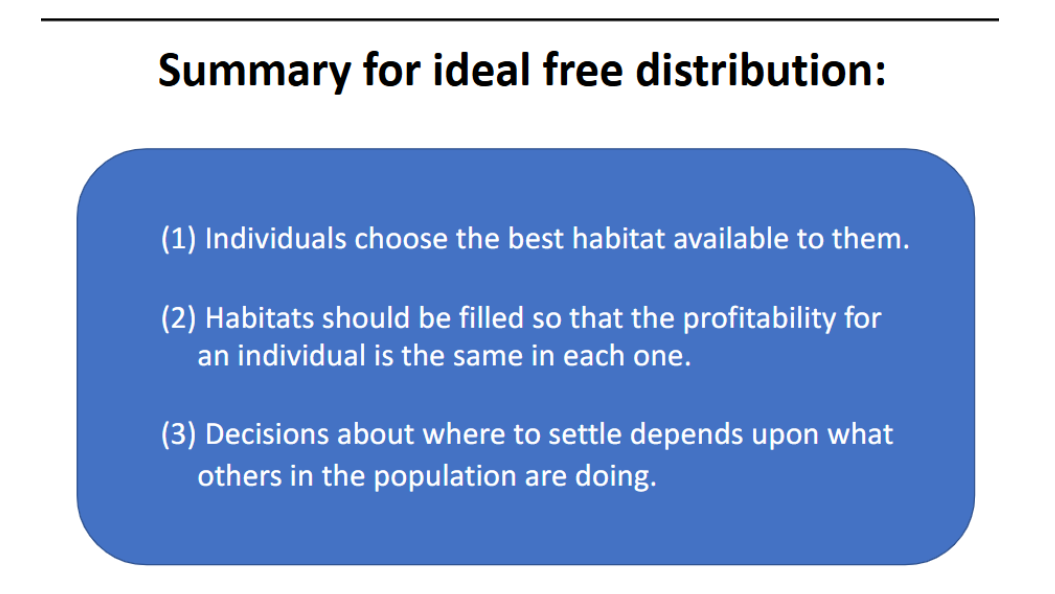
despotic distribution
I claim the room for myself
Everyone has their own territory and they fight
Sneakers are often younge males that get access to resources by sneaking around the richer habitat and sneak-mating with females
Territory is an area defended by animals against others
Animals will fight fiercely over this territory
Dragonfly may have territory of a single leaf
Woodpeckers would get a hole as their territory in many species the male is more likely to be defending
Also territory defense where females defend against females and males defend against males
meerkats will fight to death because the desert resources are scarce
Despotic Distribution
Aggressive protection of resources
Has a big metabolic cost to fight
Once good territory is gone, it is gone → they might have to change up their strategy
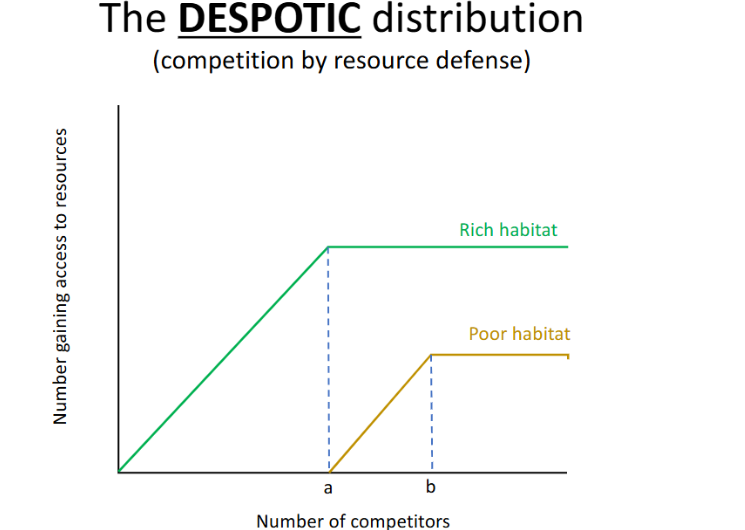
Factors influencing territoriality
Resource quality
Resource distribution in space and time
Nature of competition for resources
what happens to territoriality if there is even food distribution?
there is no territorial behavior
Small food clumps → territorial behavior
Large food clumps → no territorial behavior
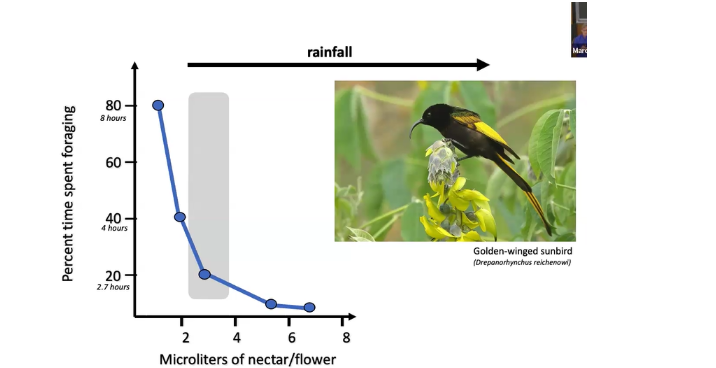
explain these graphs
Dynamics of territory size
Territory size and flower density per m^2
Rainfall increases, percent time spent foraging
Golden winged sunbird is a specialist who has a beak designed to fit a certain kind of flower
Y axis → amount of time spent foraging (during dry season, more than half your day), during rainy season it’s not bad
They are only territorial when there is nectar present in the flowers and only when it’s a limited amount
When there is no nectar there is no territory to defend
When there is an abundance of nectar there is enough that they don’t need to be territorial
Measure metabolic cost (in lab)
Look at behavior in field
Calculate energy saved minus the perching compensation time
Where do you use more calories? Seems like defending costs more calories than it is beneficial
This means defending is less beneficial.
More individuals around → must be more territorial

Is territoriality flexible?
Yes Birds can defend, adjust size of territory, maintain or abandon territory size, etc.
Natural selection favors complex behavior that is NOT genetically fixed.
Evolutionary Stable Strategy
Strategies in populations that are evolutionarily stable
Game theory
Works in cases with limited resources
Look at examples in the animal world and how these dynamics can explain them
ESS Strategy → if adopted by all members in the population it cannot be bettered by an alternative strategy
Examples sitting at a concert is NOT an ESS (bc it can be invaded by a better strategy)
Since a few people can still stand up, they will invade my strategy and this introduces a new strategy making sitting not an ESS
Example of fishing in gulls (might not be an ESS because it can be invaded by birds that don’t want to hunt and instead will steal )
What is the new stable strategy?
Everyone can’t steal and everyone can’t fish
New strategy → mixed strategy
What is the optimal percentage of each animal being involved in the strategy
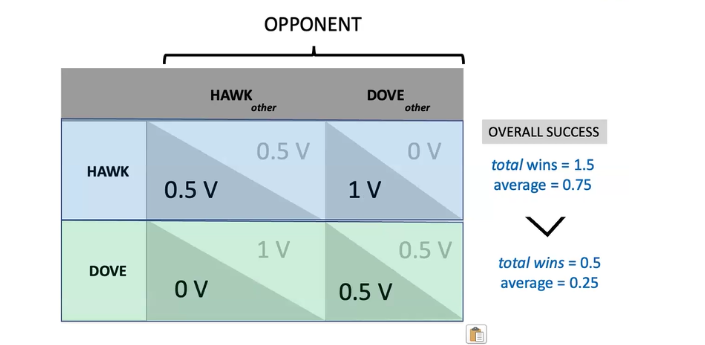
Hawk and dove game + calculations
hawk and dove are not species of animals, are representative of behaviors
Version of game theory
Territory defense and fighting are costly in terms of time, energy and risk of injury or predation
Injury is costly
Best strategy between being an aggressive fighter or being submissive/sharing
Animals can change strategy based on the situation
Used to protect resources, and based on what others are doing in the population
Ex. predators eat all of the morphs that are most frequent in the population, then second most frequent etc.
Hawk always fights and may injure opponents, they also run the risk of injuring themselves
Doves never fight
What is the optimal strategy in the population?
In this population, the stable strategy is not to be a hawk because there is a possibility of me losing against another hawk
Could also be fitness benefits such as access to a mate Changes the relationships between when it is beneficial to be a hawk and when it is beneficial to be a dove
Given cost and resource/value numbers to plug into the equation and find then when the system is at equilibrium
Being a hawk or dove is not a fixed trait
*Instead of finding f at equilibrium can also calculate over the range to see the comparison for different percentages of either hawk or dove behavior
Equilibrium point indicated is where everyone benefits the most
If there are very few doves in the area but several hawks,
Advantageous to be a dove because hawks will infight
Even if I get resources taken, I don’t incur a cost
If there are many doves but few hawks it is beneficial to be a hawk because i only encounter doves from whom I can easily steal resources
These scenarios are rare because animal would convert their behavior to the advantageous type until it is no longer advantageous
Top of the y axis is the fitness benefit and the bottom is the fitness cost
Balance can be shifted based on the value of the resource in the context and the value of the cost in the context
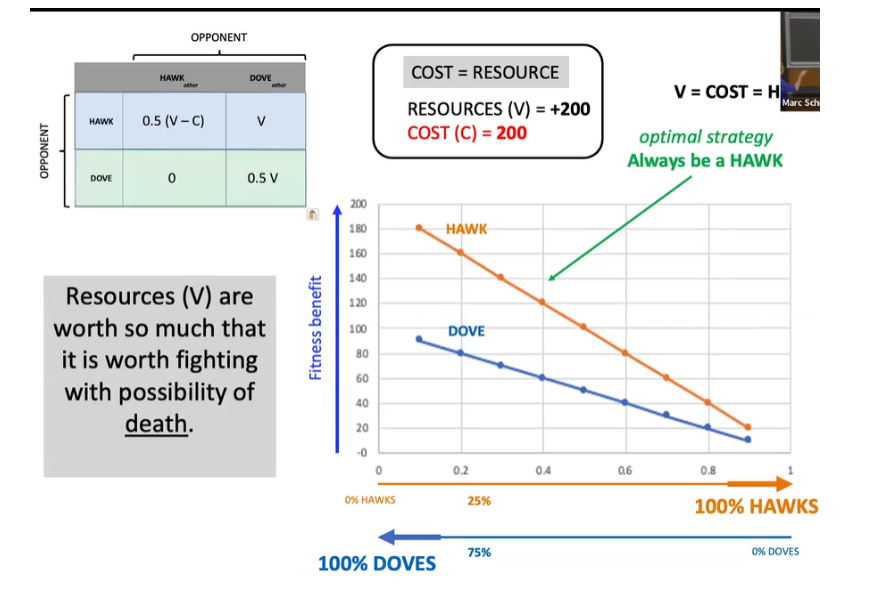
Fighting Between Male Fig Wasps
Infertile eggs → female
Fertile eggs → males
Figs have infertile eggs of female wasps in them
They emergy
Males emerge before females → they are built to fight
Goal is to fight other males to copulate with the unborn females
They copulate with females before they are born
Then they bore a hole in the figs and allow the females to leave where they lay eggs in a new fig
High cost and high rewards
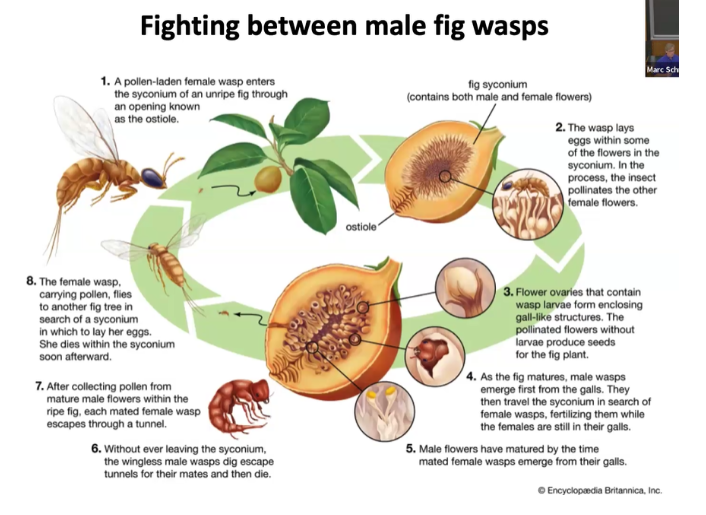
Mixed Strategy Examples → Capercaillie bird and toads WILL BE ON MIDTERM PROLLY
Capercaillie Bird Example
Capercaillie only acts as a hawk during certain parts of the year
Individuals adopt a mixed strategy playing hawk n% of the time and dove (1-n)% of the time
Toad Example of Mixed Strategy
Large male (60%) mating call (super loud)
Smaller (satellite) male (40%) → sneaker
Males cannot cheat on their call and change the sound or anything
Phonotaxis Experiment
Play calls around females in a box or something idk using a speaker
Females always go to the male frogs
Smaller males have a higher chance of not being preyed upon
Wait until the female is going towards a large male, and then they sneakily jump on the female and copulate
Based on the call behavior and volume of an individual frog, it can impact the likelihood of them adopting a specific phenotype
If the neighbor has a 4x louder call, will choose to stay silent and adopt the sneakier behavior
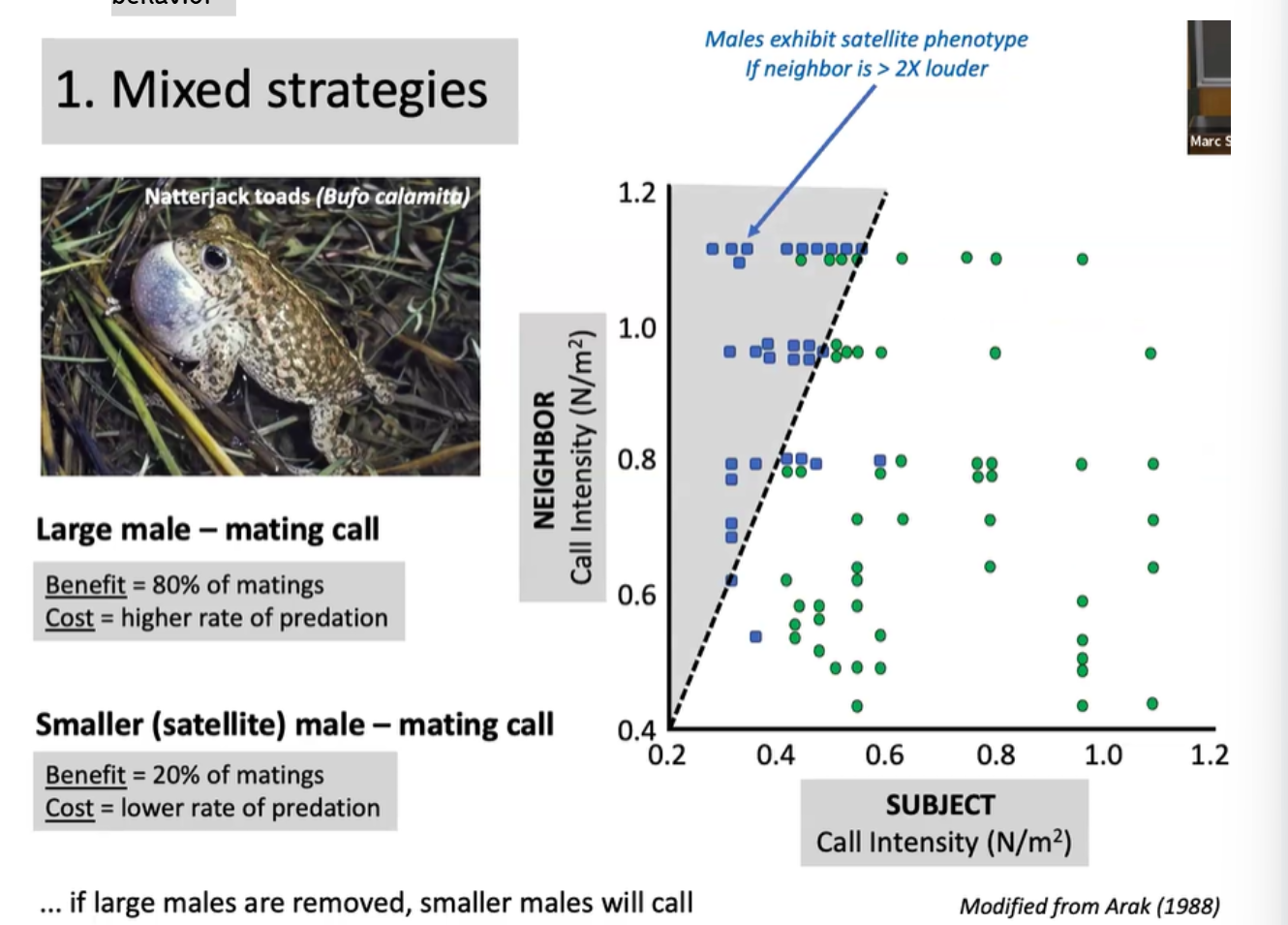
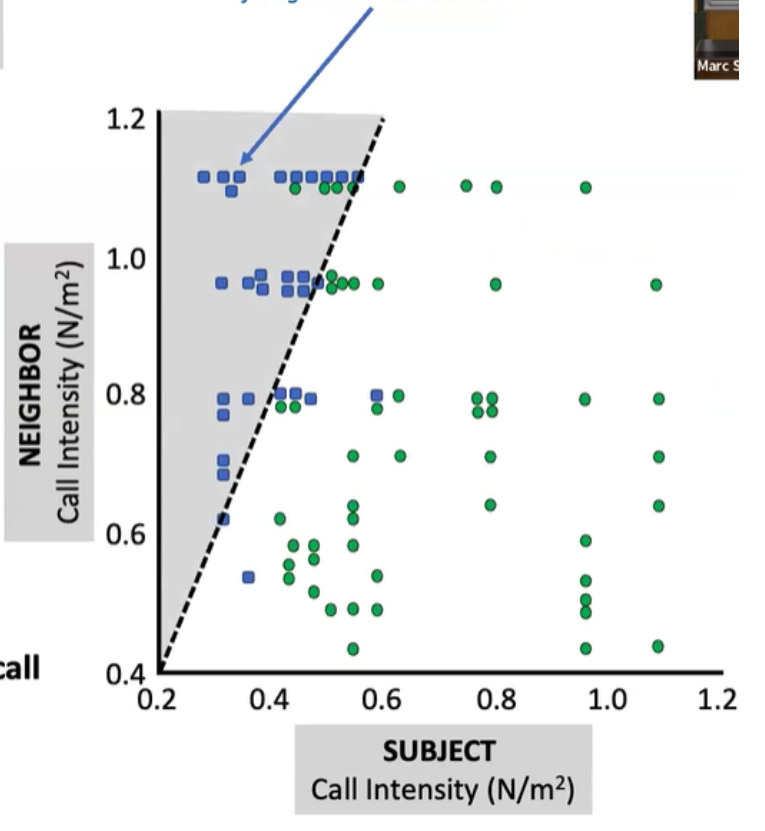
explain this graph
Large male (60%) mating call (super loud)
Smaller (satellite) male (40%) → sneaker
Males cannot cheat on their call and change the sound or anything
Phonotaxis Experiment
Play calls around females in a box or something idk using a speaker
Females always go to the male frogs
Smaller males have a higher chance of not being preyed upon
Wait until the female is going towards a large male, and then they sneakily jump on the female and copulate
Based on the call behavior and volume of an individual frog, it can impact the likelihood of them adopting a specific phenotype
If the neighbor has a 4x louder call, will choose to stay silent and adopt the sneakier behavior
Frogs are born with different morphs → smaller causes them to be quieter and larger causes them to be louder
If you are louder than your neighbor you will make a sound
If you are quieter than your neighbor you won’t
Evolutionarily stable polymorphic state → sand piker lizards, guppy fish, sand pipers
Guppy fish with five different morphs
Sand piker lizard example
Three different colors (yellow red blue orange)
Fixed evolutionary measures to maintain the relationship between these males and their morphs
Red blue yellow and orange are genotypically different
Morph can also be based on diet in other animals, such as beetle
Sandpipers
Fluff feathers to attract females
Three kinds of males are present in the population
All of them have different fitness characteristics
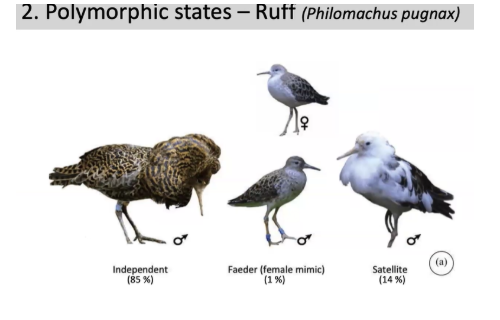
Group size determinants
Depends on the cost of being in the group
Group sizes are dynamic based on the circumstances around them
Feeding Rate
Is it determined by dominant or subordinate?
It’s determined by the subordinate
Subordinate birds tend to have a larger group size
Who determines the group size?
Dominant birds chase the subordinate away?
No → subordinate determine the group size.
Subordinate vs Dominant
Alone → same feeding rate
In group → in a group, subordinate loses more food while the dominant will steal more food
Dominant always wants to be in a group
Subordinate gets less advantage because the dominants in the group would steal their food
Hawks in a group are able to hunt prey they would not be able to hunt alone
Did not intentionally coordinate
Chimpanzees each have a role or function in the group
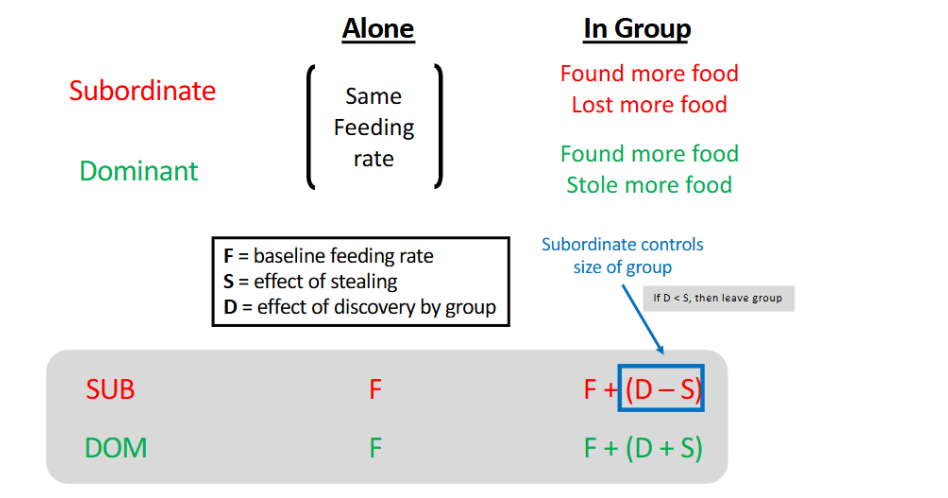
Animal Communication
Required reading of the animal communication chapter
At human language you can stop
Communication
Simple is between two individuals
Subject A is the Sender and Subject B is the receiver
Receiver makes a decision on whether to respond or not to respond
Intentional signaling from one individual (sender) to another (receiver) that affects the current or future behaviors of the receiver
Example with birds
Put female bird in a cage and playing the sound of a male song
Causes female to present herself for copulation
After a long time of hearing song, causes elevated hormone levels in female that make her more receptive to the male
Signal evolved due to the effects it has on the receiver
Signalling impacts the fitness of one or both individuals
Increases my fitness if I have a strong song that draws in a female
Increases female fitness because she can copulate and pass on her genes
Acoustic signaling
Sound in birds, fish, whales etc
Can be heard or not
Can also be vibrations instead
Visual
Can be movement, color, and positioning
Dog signal scared when hunch its back
Chemical
Smell
Pheromone trail
Scent marker
Dung scent → rhinos can tell the age and the testosterone levels of the male that shat there
Trophallaxis → sharing information by exchanging fluids via mouth
Partially nutritional, but they use it to share chemicals with each other
Tactile
Physical touch
Electric
Fish produce weak electrical signals in murky water that allows them to transmit information about food source, group, quality etc
Pre-existing trait hypothesis; from cue to signal
Sender: exhibits pre-existing traits (ex. Behavioral, physiological, and or morphological) that provides cues to receivers
If exaggeration of these cues can increase reproductive fitness, natural selection will act on them causing these cues to evolve into communication signals
Ritualization -> transformation of cue to signal
Example → piloerection (feather or fur stick up) creates like a cushion of air around their bodies that acts like an insulator
Topknot in birds → feather on top of head can be moved using piloerection
Dominant male will put their feather forwards while the submissive male will pull his backwards
Not a communication signal
If I sweat, allowing mosquitoes to be more attracted to me, I am not communication
This is an unintentional signal
Secondary effect of a physiological response is a cue rather than a signal
Another example
Frog, body shape signals to the predator that the predator should eat it
Not a communication signal, it is only a cue
Cue does not evolve due to the effects it has on the receiver
Red coloration of frog would be communication if it is an example of aposematic signalling
This also increases its fitness because it makes it less likely to be eaten by a predator
Predator receives signal as not wanting to each something that is poisonous
index signal
honest signals that cannot be faked
Physical constraint
How do animals decide how to behave in contests?
When should they be hawks and when should they be doves?
Natural selection favors ‘displays’ because..
It ensures that strongest (dominant) individuals win contests
Protects subordinate animals for costly fights
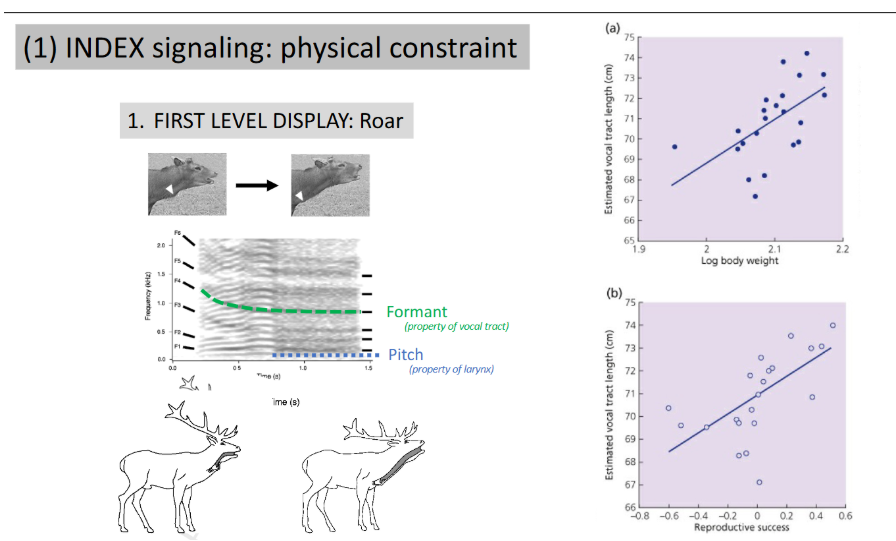
Multimodal
Australian jumping peacock spider
Male spider use jumping and color display
McGurk Effect → how you perceive multimodal signals
Signal Reliability and Signal Honesty
Frequency of roar correlates with the size
Signal reliability → signal is reliable when it is consistently (on avg) correlated with some attribute of the signaler (ex. Body size) or the signaler’s environment
Need to prevent lying and cheating because otherwise communication cannot be trusted
Ex roar sound being shaped by the size of the vocal cord of the animal → helps to estimate the size of animal
These deer are able to change their larynx size to make themselves seem bigger → then everyone can lower their larynx → everyone goes as low as they can and it ends up representative of their body size
Signal Reliability and Conflicts of Interest examples
Cuckoo bird example, the bird presents yellow dots on their wings to make mother think there are three beaks
Drongo bird learns alarm calls from another bird species, approach other bird species when they have foraged food, and then make an alarm call when they are there and eats their food
Changes the species they target so the target species does not catch on
what are types of displays that ensure signal honesty?
Index signal (signal indicating the body size)
Handicap signal (body appendage that can be costly)
Badge of status signal (low cost body appearance)
Socially shamed if the signal is faked
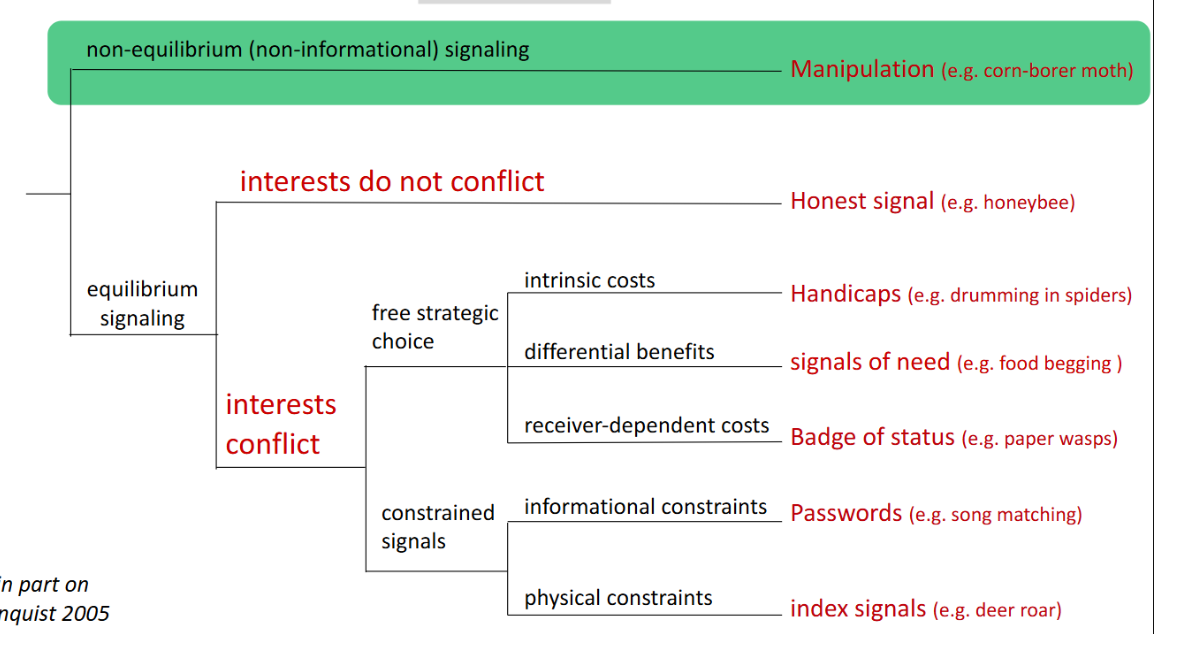
Nonequilibrium/non-informational signaling
Example here is manipulation of corn moth and the water mite too
Read textbook
Sensor bias → sensory and neural systems have biases that have evolved in other contexts
Sensory exploitation → signalers evolve signals that exploit these biases
Receiver has no choice due to exploitation of an ancestral/evolutionary trait
Sensor bias
Sensor bias → sensory and neural systems have biases that have evolved in other contexts
Sensory exploitation
signalers evolve signals that exploit these biases
Receiver has no choice due to exploitation of an ancestral/evolutionary trait
Corn moth example
Coexist with bats for 150 million years
What sender wants from receiver is not always what the receiver wants from the sender
Male vs female
Male wants to inseminate every female possible
Female wants to be picky because it takes a lot of energy to have eggs
Batesian mimicry can also be by sound
Hypothesized evolutionary timeline
Moths evolve ultrasonic hearing to detect bats and trigger escape response
Some moths evolve ultrasonic communication for
Signal aposematism
To jam the bat signal
Some moths can co opted response of female moths to ultrasound for mating purposes
Moth strategies
Moth hearing bat sonar signals → they start evasively flying if they are nearby
If they are far away, they freeze and hope the bat doesn’t notice them
3 cm away female can’t hear the male
Once it gets to copulation range, it sounds much louder
Low intensity sound induces a freezing response in the female → coopts ancestral freezing response and the female is paralyzed and copulated with by the male
Loud sound of bat song compared to courtship call
Louder call = wiggle around more for bat call
Louder call for courtship = avoidance as well
Since female has no choice then there is no i
Information and response
Eusocial communication
Honeybees are computing distance using optic flow
Return to hive and want to communicate with them
Waggle dance
WE NEED TO KNOW HOW THE WAGGLE DANCE WORKS
Longer time spent doing the dance = further distance from the food source
Based on energy expenditure, if it’s windy they may do a longer dance because it takes more energy
Red deer example of index signaling
Red deer are protecting resource of females
Roar is hard to cheat because it is tied to their body size → evolved some tricks to create a dishonest signal
Cheating link between body size and roar volume, except everyone started doing this so it ended up matching the body size again
Red deer have a vocal tract and a larynx (Adam’s apple) and a trachea that extends to lungs
Length of vocal tract is related to overall body size
Present roar on a spectrogram/sonogram
Two seconds in length
Greyness = loudness
Pitch is a property of the larynx
However, pitch is not a reliable measurement of body size
Formants → property of vocal tract
More reliable measure of vocal tract
Correlates with vocal tract length
Compare vocal tract length with the log body weight
Estimated vocal tract length and reproductive success have a positive correlation
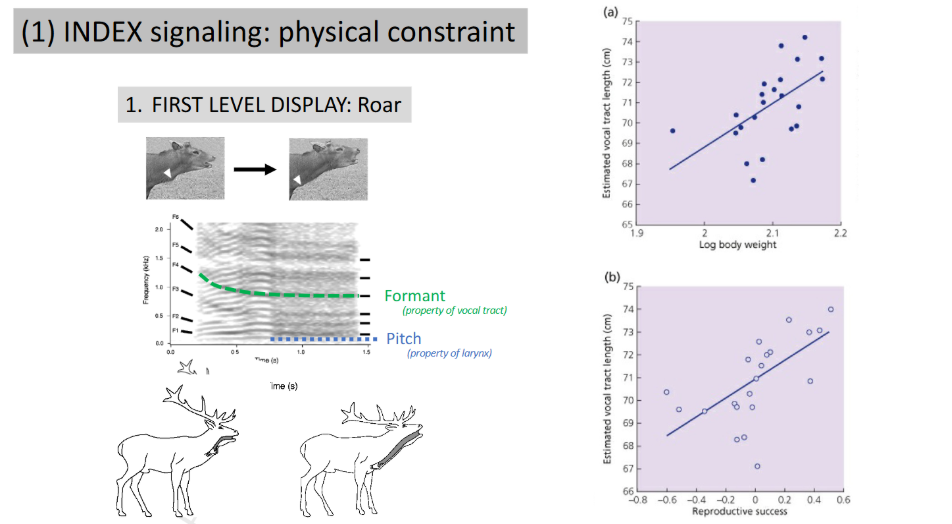
Parallel Walk
They walk past each other multiple times to size each other up
The closer they are in size, the more likely they are to spend more time evaluating each other
Also takes place in male cichlid fish
Handicap Signal
Body appendage
These are mostly honest signals because dishonesty is possible but not profitable
Examples are peafowl, stalk-eyed fly
Handicap principle (Zahavi)
signals can be honest if they are costly
There is a cost for dishonesty in this system
Ex. signing up to run a marathon with a friend and you can’t run at all
Benefit here → reproductive success
Signal intensity → low cost signal = low benefit
Increase cost signal = increase in benefit and increase in cost
Middle black line indicates the maximum profit for the animal
Can’t die year 1 → lose opportunities for mating
Wolf Spider Handicap Signaling example
Tap their limbs on the ground
Used to doing it on leafy material
Sends signal to other spiders as a part of a courtship ritual
Females do prefer males that drum/thump
Females prefer males that do more thumps
Three different categories of male and calculate their drumming rate (they only drum when there are females)
High, medium, low fitness group
How do I generate these three groups?
Took spiders and gave them varying nutritional regiments
Drumming is energetically costly
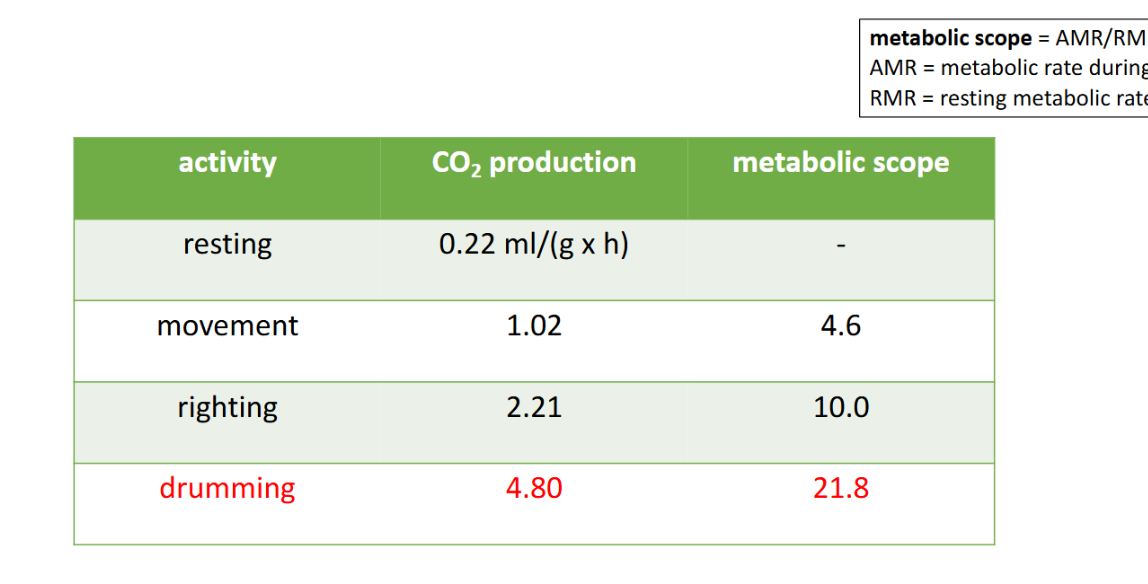
Stalk Eyed Flies
Costly for the males to produce a stalk
Big stalked male is preferred by female
Gave different diets to different flies
Measure wing size for fitness and eye stalk for female preference
Males put more energy into making their eyestalks longer
If there is less energy available, the males must make a decision to prioritize eye growth or wing growth
Only males that are very robust, strong, high quality can grow the eyestalk.
Can try to grow large eyestalks even if you don’t have energy
Bigger eye = bigger body = stronger
They choose to grow their eyes !! not like deer
Badge of Status
Social shaming
Color feather in songbirds is related to testosterone levels and some birds try to cheat the system, but then you get socially shamed by your group
Paper wasps
Color marks on their faces
Number of markings are tied to diet and dominance in the group
Use sharpie to change the number of markings
Less dots = more subordinate
More dots = more dominant
Put two wasps together and make them fight
More dots always wins, then you can do brackets and see who is the most dominant and least dominant
Place dead wasp near food source
Wasps always go to the foodsource where there is a less dominant male (dead) by it
Choose to avoid conflict
Cheat system
Pair together the fake dominant with the fake submissive
When the fake submissive one wins, the cheating (fake dominant) wasp gets socially harassed
Badge Cost
Energetics → costly to produce, weak individuals do not have it
Social cost
Get bullied